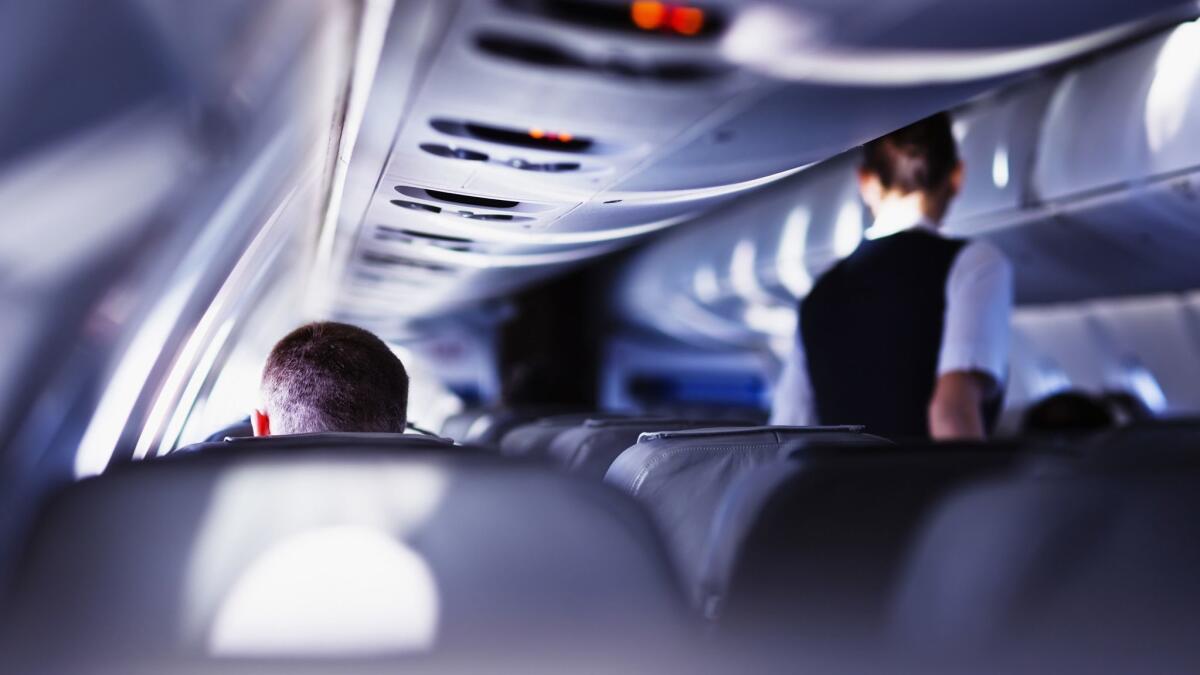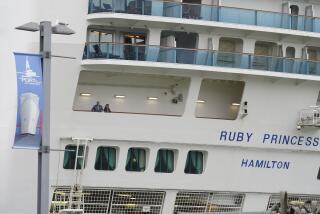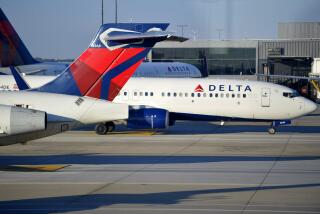Passing out on a plane is pretty common. What happened with this drunk was not

- Share via
On long-haul flights of six hours or more, it’s not unusual for at least one passenger to lose consciousness.
During my 30-year career as a flight attendant, no fewer than 300 passengers have passed out while I was on duty. (This is a conservative estimate based on about one fainting victim a month for the last three decades.)
People faint for a variety of reasons, including dehydration, irregular heart beat, low blood sugar, hyperventilation, a sudden drop in blood pressure, standing up and, of course, drinking alcohol, according to WebMD.com. On an airplane, where air circulation is notoriously poor, the lack of oxygen to the brain because of high cabin pressure can exacerbate the problem. Warm cabin air can make matters worse, which is partly why the temperature in an airplane cabin is often set to an uncomfortably cold level.
Two sides to this story: Airline passenger wanted flight attendant fired for making her change her shirt, but he could have been fired if he hadn’t.
None of my fainting passengers suffered serious medical complications. Most woke within seconds after collapsing and were back to normal after drinking orange juice or water. Some required oxygen that my colleagues or I administered.
Every fainting passenger did so publicly, in front of dozens of people. The person typically rose from his or her seat, stumbled down the aisle or leaned, on wobbly legs, against a bulkhead. And then … bam! The person crumpled to the floor amid gasps from fellow passengers, who alerted the crew.
But what happens when a passenger loses consciousness and no one witnesses the event? I found out on a recent flight from Miami to Saõ Paulo, Brazil.
The incident occurred about 4 a.m., halfway through the eight-hour flight. The airplane cabin was dark, save a few flickering seatback monitors and passenger reading lights. Most of the 304 passengers dozed in their seats.
For a few moments, I was the only crew member attending the first-class cabin. Our Boeing 777-300 had a first-class configuration of only eight seats. The 12 other flight attendants milled about in business class, the main cabin or slept in the crew bunks during a contractual break.
While sitting on my jump seat, immersed in a novel, I heard a loud thumping. I stood up to scan the first-class cabin. All eight passenger seats were lying flat. Everyone appeared to be sleeping peacefully except the man in seat 1A. Moments earlier, he had left his seat to use the lavatory.
The thumping persisted and the sounds were coming from the same lavatory the passenger had entered.
Years earlier, on a different long-haul flight, I heard thumping noises originating from a lavatory. Concerned about the passenger’s well-being, I banged on the door and shouted, “Are you OK?” After several seconds, the door opened. Two red-faced lovers stepped out.
But the passenger on my Saõ Paulo flight was alone when he stepped into the lavatory.
I approached and knocked softly on the door. “Are you OK?” I asked.
No answer.
I knocked harder.
No response.
Knocking on a lavatory door is a complicated proposition for a flight attendant. Perhaps the occupant is refusing to respond because he or she has a reasonable expectation of privacy and wants to be left alone. Perhaps he or she is wearing headphones and can’t hear the knock. Or maybe the occupant assumes an impatient person is pressuring them to hurry nature’s call.
In this case, however, I was sure the occupant was in peril. The thumps sounded as though a heavy object had been thrown against the lavatory wall.
I summoned Paulo, another flight attendant, and asked for his help.
Standing together outside the lavatory, both of us knocked on the door.
Still no response.
Using the door lock override switch outside the lavatory, I opened the door. Paulo and I looked inside and said, “Oh, goodness” (or an approximation of that) in unison.
The passenger’s body was wedged between the toilet seat and wash basin. Eyes closed, mouth agape, he appeared to be unconscious.
Following airline procedures detailed in our electronic in-flight manual, we shook him by the shoulders and asked whether he was OK. He did not respond. We then checked to see whether he was breathing. He was. We shook him again. “Are you OK? Are you OK?”
Before we could drag his body from the lavatory, stretch him on the floor and alert the captain, the passenger woke up. Embarrassed, he apologized for drinking what he claimed to be “too much alcohol.”
After a few moments, the man regained his composure. Paulo and I escorted him to his seat where he slept soundly for the rest of the flight.
About a third of all in-flight medical emergencies involve loss of consciousness, or syncope, according to the Journal of the American Medical Assn. Other common emergencies are classified as gastrointestinal (14%), respiratory (10%) and cardiovascular (7%).
If the most common emergency is loss of consciousness, the most common reason passengers lose consciousness is drinking too much alcohol. Excess alcohol causes dehydration. Dehydration can limit the flow of oxygen to the brain. A lack of oxygen, combined with airplane cabin pressure, can make some passengers feel as though they’re sitting on a cliff at 8,000 feet and can lead to an in-flight fainting spell.
It’s a scary situation for passengers and crew. Maybe the drink passengers should always order is water — and not as a chaser. Cheers.
More to Read
Sign up for The Wild
We’ll help you find the best places to hike, bike and run, as well as the perfect silent spots for meditation and yoga.
You may occasionally receive promotional content from the Los Angeles Times.







